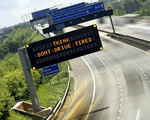 Go to main content
Go to main content
Archive Website of the UK government
Please note that this website has a UK government accesskeys system.
Main menu
Page menu
Travel and transport

Electronic message signs

There are nearly 3,000 electronic message signs (or variable message signs) on England's trunk road and motorway network. Learn what the different signs mean and how they work with automatic traffic management systems.
Electronic message signs - the basics
Electronic message signs appear across the system and can show different messages as needed.
They come in various sizes: from smaller post-mounted signals on the central reservation to large signs on overhead gantries. There are even mobile electronic message signs that can be used to display real-time traffic information where there are no fixed signs available.
Their aim is to improve road safety and reduce the impact of congestion by giving drivers up-to-the-minute information about road and traffic conditions.
They display, among other things:
- variable speed limits set in response to traffic conditions ahead
- warnings to drivers of incidents, roadworks or congestion ahead
- estimated journey times or delay times
- alternative route information
- safety messages
Around 500 electronic message signs are placed at key driver decision points. This is so you can use information about conditions on the road ahead to change your route if necessary.
The signs are used only for messages that can help drivers – never for unnecessary information or advertising.
What messages the signs can display
There are four main types of message:
- incident management – messages like 'ACCIDENT SLOW DOWN' and 'DIVERSION AT NEXT JCT'
- driver information – messages like 'M6 CLOSED NEXT JCT', 'M1 NORTH CONGESTION' and 'TO J6A (FOR M25) 115 MILES 1 HR 40 MINS'
- strategic diversions – messages like 'M40 CLOSED J10 FOR LONDON USE M6 (S), M1 (S)'
- roadworks – messages like 'WORKFORCE IN ROAD – SLOW'
Pictograms
Pictograms have recently been introduced on certain stretches of motorway to give drivers extra information. To see the pictograms currently in use, see 'What the electronic message signs mean'.
Safety campaigns
When there are no urgent messages about delays, incidents or congestion, some electronic signs display safety campaigns messages from the Department of Transport (DfT). These could include:
- 'WATCH YOUR SPEED'
- 'KEEP YOUR DISTANCE'
- 'THINK! DON'T PHONE WHILE DRIVING'
How the signs work
The messages that signs display can be set:
- by an operator in one of the Highways Agency control centres
- automatically in response to road conditions ahead
Around 80 per cent of messages are set automatically.
Automatic messages may show:
- journey time information – this is set in response to real-time movement of traffic along the network, detected by sensors and automatic number plate recognition cameras
- queue or incident warnings – these set recommended speeds of 60, 50 and, if necessary, 40 miles per hour and are controlled by road sensors that detect slow-moving traffic ahead
Queue or incident warnings are designed to slow drivers down before they reach a queue to avoid stop-start driving. That is why sometimes the queue or incident is over by the time you reach it.
Electronic message signs and Controlled or Managed Motorways
Controlled and Managed Motorways are systems for traffic management currently in use on the M25 and M42. They both use electronic message signs to regulate traffic flows.
You can find more information about these systems and the electronic message signs they use by following the link below.
 Facebook
Facebook Twitter
Twitter StumbleUpon
StumbleUpon Delicious
Delicious Reddit
Reddit